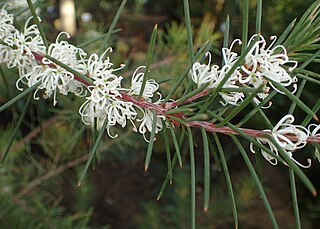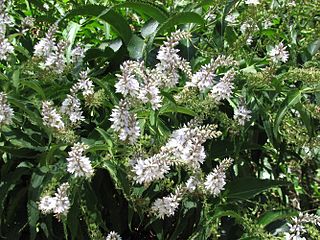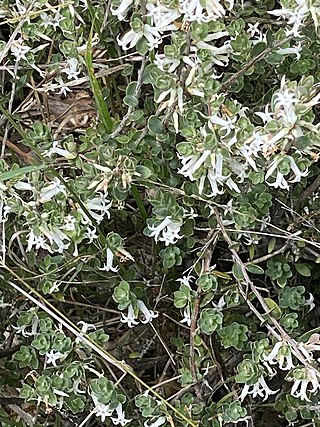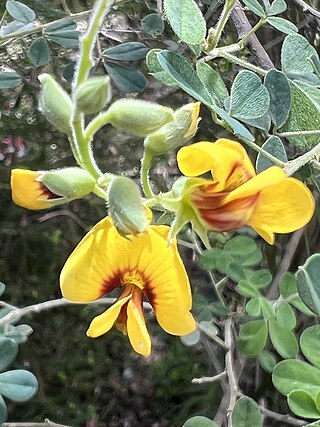
Hakea salicifolia commonly known as the willow-leaved hakea, is species of flowering plant that is endemic to eastern Australia. It is an adaptable, fast growing small tree or shrub with attractive foliage and cream white flowers.

Hakea sericea, commonly known as bushy needlewood or silky hakea, is a large shrub with a profusion of mainly white flowers from July for several months. It is endemic to eastern Australia. It has become an environmental weed in some countries.

Olearia phlogopappa commonly known as the dusty daisy-bush or alpine daisy-bush is a species of flowering plant in the family Asteraceae that is commonly found in eastern New South Wales, Victoria and Tasmania. It is a small shrub with greyish-green foliage, daisy-like flowers in white, pink or mauve that can be seen from spring to late summer.

Scaevola hookeri, commonly known as the creeping fan-flower or alpine fan-flower, is a species of flowering plant in the family Goodeniaceae. It has white or blue flowers with a yellow throat and grows in eastern Australia.

Veronica derwentiana, commonly known as Derwent speedwell, is a flowering plant species of the family Plantaginaceae, endemic to south-eastern Australia. It is a perennial with toothed leaves and white or pale blue flowers in terminal sprays in spring and summer.

Brachyloma daphnoides, commonly known as daphne heath, is a flowering plant in the family Ericaceae. It is a small upright shrub with dull grey-green leaves and white tubular flowers.

Olearia erubescens, commonly known as moth daisy-bush or pink-tip daisy-bush, is a species of flowering plant in the family Asteraceae. It is a shrub with stiff, prickly leaves and white "daisy" flowers, growing up to 2 metres high.

Hovea montana, commonly known as alpine hovea, mountain hovea or alpine rusty-pods, is a flowering plant in the family Fabaceae, and is endemic to Australia. It is a small shrub with narrow leaves and purple pea flowers.

Olearia asterotricha, commonly known as rough daisy-bush, is a species of flowering plant in the family Asteraceae. A tall shrub with white, mauve or blue daisy like flowers growing from the Blue Mountains in New South Wales to western Victoria, Australia.

Hakea eriantha, commonly known as tree hakea, is a shrub or small tree endemic to the east coast of Australia. It has white flowers on a woolly stem in leaf axils, long narrow leaves with reddish new growth. Found growing at higher altitudes in moist or sclerophyll Eucalyptus woodland.

Lophospermum erubescens, known as Mexican twist or creeping gloxinia, is a climbing or sprawling herbaceous perennial plant, native to the Sierra Madre Oriental mountains of Mexico, where it is found along forest margins or canyon walls. It climbs by means of twining leaf stalks. Wild plants have pink and white tubular flowers, although other colours are found in cultivation. It has been cultivated as an ornamental plant since at least 1830. Although not frost-hardy, it will survive if its base and roots are protected from freezing in the winter. It has escaped from cultivation and become naturalized in tropical and subtropical areas of the world.

Lobelia anceps, commonly known as angled lobelia, is a small herbaceous plant in the family Campanulaceae it grows in several states of Australia, New Zealand, South America and South Africa. It is a small, perennial herb with blue to purple flowers.

Leucospermum erubescens is an evergreen shrub of up to 2 m high, with hairless, lancet-shaped to oval leaves with three to seven teeth near the tip of 7–8½ cm long and 1–2 cm wide, slightly asymmetric, oval flower heads of 5–6½ cm in diameter, and usually with four to eight clustered near the end of the branches, with initially yellow flowers, that change to deep crimson, from which long styles stick out, giving the flowerhead as a whole the appearance of a pincushion. It is called orange flame pincushion in English and oranjevlamspeldekussing in Afrikaans. It can be found in South Africa. Flowers may be found between August and January.

Scaevola calendulacea commonly known as dune fan-flower, is a flowering plant in the family Goodeniaceae. It is a small, mat-forming shrub with blue fan-shaped flowers with a yellow centre and grows on sand dunes in eastern and southern Australia.

Olearia brevipedunculata, commonly known as the dusty daisy-bush, is a small shrub with whitish-grey foliage and white daisy-like flowers in summer. Mostly found in Victoria and scattered locations in New South Wales, Australia.

Brachyscome graminea, commonly known as grass daisy, is a perennial herb in the family Asteraceae and is endemic to Australia. It has mostly mauve-pink or purple daisy-like flowers and a yellow centre.

Olearia minor, is a small flowering shrub in the family Asteraceae. It has alternate leaves and white to pale mauve daisy-like flowers from winter to December. It grows in Western Australia, South Australia, New South Wales, and Victoria.

Solanum sturtianum, commonly known as Thargomindah nightshade, is a flowering plant in the family Solanaceae. It is an upright shrub with grey-green leaves and purple flowers. This species is endemic to Australia.

Convolvulus simulans is a species of annual plant in the morning glory family known as the small-flowered morning-glory and small-flowered bindweed. It is an inconspicuous vining plant that is characterized by tiny pale pink or pale blue bell-shaped flowers. It is typically restricted to clay and serpentine substrates in annual grassland, coastal sage scrub and chaparral habitats. This species is native to Arizona, California, and Baja California. Some taxonomies place this species under Convolvulus equitans.

Goodia pubescens, commonly known as golden tip, is a flowering plant in the family Fabaceae. It has yellow pea flowers, bluish-green leaves and found in Victoria and New South Wales.




















